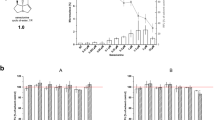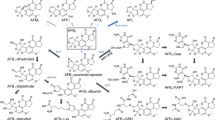Abstract
The effects of the herbicides fomesafen, oxyfluorfen, oxadiazon and fluazifop-butyl on porphyrin accumulation in mouse liver, rat primary hepatocyte culture and HepG2 cells were investigated. Ten days of herbicide feeding (0.25% in the diet) increased the liver porphyrins in male C57B1/6J mice from 1.4±0.6 to 4.8±2.1 (fomesafen) 16.9±2.9 (oxyfluorfen) and 25.9±3.1 (oxadiazon) nmol/g wet weight, respectively. Fluazifop-butyl had no effect on liver porphyrin metabolism. Fomesafen, oxyfluorfen and oxadiazon increased the cellular porphyrin content of rat hepatocytes after 24 h of incubation (control, 3.2 pmol/mg protein, fomesafen, oxyfluorfen and oxadiazon at 0.125 mM concentration 51.5, 54.3 and 44.0 pmol/mg protein, respectively). The porphyrin content of HepG2 cells increased from 1.6 to 18.2, 10.6 and 9.2 pmol/mg protein after 24 h incubation with the three herbicides. Fluazifop-butyl increased hepatic cytochrome P450 levels and ethoxy- and pentoxyresorufin O-dealkylase (EROD and PROD) activity, oxyfluorfen increased PROD activity. Peroxisomal palmitoyl CoA oxidation increased after fomesafen and fluazifop treatment to about 500% of control values both in mouse liver and rat hepatocytes. Both rat hepatocytes and HepG2 cells can be used as a test system for the porphyrogenic potential of photobleaching herbicides.
Similar content being viewed by others
References
Adler IL, Jones BM, Wargo JP (1977) Fate of 2-chloro-1-(3-ethoxy-4-nitrophenoxy)-4-(trifluoromethyl)benzene (oxyfluorfen) in rats. J Agric Food Chem 25: 1339–1341
Blaauboer BJ, Wortelboer HM, Mennes WC (1990) The use of liver cell cultures derived from different mammalian species in in vitro toxicological studies: implementation in extrapolation models? ATLA 18: 251–258
Brady AM, Lock EA (1992) Inhibition of ferrochelatase and accumulation of porphyrins in mouse hepatocyte cultures exposed to porphyrogenic chemicals. Arch Toxicol 66: 175–181
Burke MD, Thompson S, Elcombe CR, Halpert J, Haaparanta T, Mayer RT (1985) Ethoxy-, pentoxy- and benzyloxyphenoxazones and homologues: a series of substrates to distinguish between different induced cytochromes P-450. Biochem Pharmacol 34: 3337–3345
Butler EG, Tanaka T, Ichida T, Maruyama H, Leber AP, Williams GM (1988) Induction of hepatic peroxisome proliferation in mice by lactofen, a diphenyl ether herbicide. Toxicol Appl Pharmacol 93: 72–80
Day RS, Blekkenhorst GH, Eales L (1980) Hepatic porphyrins in variegate porphyria. N Engl J Med 303: 1368–1369
De Matteis F, Gibbs AH (1980) Drug-induced conversion of liver haem into modified porphyrins. Evidence for two classes of products. Biochem J 187: 285–288
De Matteis F, Harvey C, Martin SR (1986) N-Alkylation of exogenous haem analoques caused by drugs in isolated hepatocytes. Biochem J 238: 263–268
Duke SO (1990) Overview of herbicide mechanisms of action. Environ Health Perspect 87: 263–271
Duke SO, Lydon J, Becerril JM, Sherman TD, Lehnen LP, Matsumoto H (1991) Protoporphyrinogen oxidase-inhibiting herbicides. Weed Sci 39: 465–473
Iwasa F, Sassa S, Kappas A (1989) Delta-aminolaevulinate synthase in human HepG2 hepatoma cells. Biochem J 262: 807–813
Jacobs JM, Sinclair PR, Gorman N, Jacobs NJ, Sinclair JF, Bement WJ, Walton H (1992) Effects of diphenyl ether herbicides on porphyrin accumulation by cultured hepatocytes. J Biochem Toxicol 7: 87–95
Kappas A, Sassa S, Anderson K (1983) The porphyrias. In: Stanbury JB, Wijngaarden JB, Frederickson DS, Goldstein JL, Brown MS (eds) The metabolic basis of inherited disease. McGraw-Hill, New York, pp 1301–1384
Kennedy SW, Wigfield DC (1990) Dose-response relationships in hexachlorobenzene-induced porphyria. Biochem Pharmacol 40: 1381–1388
Krijt J, Vokurka M, Sanitrak J, Janousek V (1991) Liver HPLC porphyrin profiles in experimental porphyria induced by peroxidizing herbicides. Biomed Chromatogr 5: 229–230
Krijt J, Pleskot R, Sanitrak J, Janousek V (1992) Experimental porphyria induced by oxadiazon in male mice and rats. Pestic Biochem Physiol 42: 180–187
Lazarow PB (1981) Assay of peroxisomal beta oxidation of fatty acids. In: Lowenstein JM (ed) Methods in enzymology, vol 72. Academic Press, New York, pp 315–319
Marks GS (1978) The effects of chemicals on hepatic heme biosynthesis: differences in response to porphyrin-inducing chemicals between chick embryo liver cells, the 17-day-old chick embryo and other species. In: De Matteis F, Aldridge WN (eds) Handbook of experimental pharmacology, vol 44. Springer, Berlin Heidelberg New York, pp 201–227
Marks GS, Powles J, Lyon M, McCluskey S, Sutherland E, Zelt D (1987) Patterns of porphyrin accumulation in response to xenobiotics. Parallels between results in chick embryo and rodents. In: Silbergeld EK, Fowler BA (eds) Ann NY Acad Sci 514: 113–127
Matringe M, Camadro JM, Labbe P, Scalla R (1989a) Protoporphyrinogen oxidase as a molecular target for diphenyl ether herbicides. Biochem J 260: 231–235
Matringe M, Camadro JM, Labbe P, Scalla R (1989b) Protoporphyrinogen oxidase inhibition by three peroxidizing herbicides: oxadiazon, LS 82-556 and M&B 39279. FEBS Lett 245: 35–38
McFarland VA, Clarke JU (1989) Environmental occurrence, abundance, and potential toxicity of polychlorinated biphenyl congeners: considerations for a congener-specific analysis. Environ Health Perspect 81: 225–239
Okamoto M, Sato R, Nagano E, Nakazawa H (1991) Optical resolution and biological activities of S-23121, a new cereal herbicide. Agric Biol Chem 55: 3151–3153
Ortiz de Montellano PR, Mico BA, Yost GS (1978) Suicidal inactivation of cytochrome P-450. Formation of a heme-substrate covalent adduct. Biochem Biophys Res Commun 83: 132–137
Paine AJ, Williams LJ, Legg RF (1979) Determinants of cytochrome P-450 in liver cell cultures. In: Preisig R, Bircher J (eds) The liver: quantitative aspects of structure and function, Editio Cantor, Aulendorf, pp 99–109
Rutten AAJJL, Falke HA, Catsburg JF, Topp R, Blaauboer BJ, van Holsteijn I, Doorn L, van Leeuwen R (1987) Interlaboratory comparison of total cytochrome P-450 and protein determinations in rat liver microsomes. Arch Toxicol 61: 27–33
Sanitrak J, Krijt J, Coupek J, Janousek V, Magnus IA (1987) Determination of porphyrins in tissue: preadsorption followed by high-performance liquid chromatography. J Chromatogr 415: 129–133
Schmidt U, Machemer L (1989) Difference between species in response to a 3,5-dichloropyridyloxy-phenoxy compound: Induction of cytochrome P-450 and/or peroxisome proliferation. Food Addit Contam 6 [Suppl 1]: S41-S55
Sharma R, Lake BG, Gibson GG (1988) Co-induction of microsomal cytochrome P-452 induction and peroxisomal proliferation by hypolipidaemic agents in rat liver: a mechanistic inter-relationship. Biochem Pharmacol 37: 1193–1201
Smith AG, Francis JE, Walters DG, Lake BG (1990) Protection against iron-induced uroporphyria in C57BL/10ScSn mice by the peroxisome proliferator nafenopin. Biochem Pharmacol 40: 2564–2568
Smith LL, Elcombe CR (1989) Mechanistic studies: their role in the toxicological evaluation of pesticides. Food Addit Contam 6 [Suppl 1]: S57-S65
Stevens JT, Sumner DD (1991) Herbicides. In: Hayes WJ, Laws ER (eds) Handbook of pesticide toxicology. Academic Press, San Diego, pp 1317–1408
Varsano R, Matringe M, Magnin N, Mornet R, Scalla R (1990) Competitive interaction of three peroxidizing herbicides with the binding of [3H] acifluorfen to corn etioplast membranes. FEBS Lett 272: 106–108
Visser O, van den Berg JWO, Koole-Lesluis H, Voortman G, Wilson JHP (1991) Porphyrin synthesis by human hepatocytes and HepG2 cells-effects of enzyme inducers and delta — aminolevulinic acid. Toxicology 67: 75–83
Yanase D, Andoh A (1989) Porphyrin synthesis involvement in diphenyl ether-like mode of action of TNPP-ethyl, a novel phenylpyrazole herbicide. Pestic Biochem Physiol 35: 70–80
Author information
Authors and Affiliations
Rights and permissions
About this article
Cite this article
Krijt, J., van Holsteijn, I., Hassing, I. et al. Effect of diphenyl ether herbicides and oxadiazon on porphyrin biosynthesis in mouse liver, rat primary hepatocyte culture and HepG2 cells. Arch Toxicol 67, 255–261 (1993). https://doi.org/10.1007/BF01974344
Received:
Accepted:
Issue Date:
DOI: https://doi.org/10.1007/BF01974344




